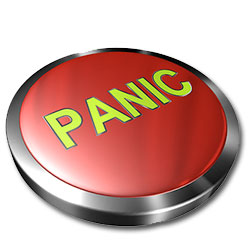 In the first part of this series (if you missed the first instalment, you can find it here), we looked at one of the main reasons a person who suffers anxiety attacks becomes labelled with a resulting phobia. This week we’re going to look at why that person becomes ‘phobic’ when the cause can be completely unrelated.
In the first part of this series (if you missed the first instalment, you can find it here), we looked at one of the main reasons a person who suffers anxiety attacks becomes labelled with a resulting phobia. This week we’re going to look at why that person becomes ‘phobic’ when the cause can be completely unrelated.
Start at the beginning
Let’s start by going back a bit to identify how the mind processes information…
Your mind is a huge library of your past experiences and the resulting smells, sights sounds, feelings and emotions.
It puts these different events and experiences together in a sort of history chain. For example… When you were a toddler, you probably touched something hot. And the shock you felt would’ve imprinted on your mind that excessive heat is painful and should be avoided. The next time you approach something hot, your mind quickly takes you back to the first encounter. Because of that, you immediately move away from the source of further pain.
It does this using a process known as ‘anchoring‘. At the peak of emotion, the mind will select anything unique to the situation and anchor it to the cause of that emotion. For example, “I am feeling intense pain, what unique thing was happening when I started to feel this pain?…. I touched something hot…. therefore hot = pain”
In the future, still as a toddler, you’ll be reluctant to touch anything hot. Because your mind flies back to the original experience whenever you approach it, reminding you of the pain you felt. If the pain wasn’t severe enough, it might take being burned a couple of times to lock it in place. This is how humans and other animals learn to survive in the World.
Breaking down the anatomy of an Anxiety Attack
 So, how does this survival skill relate to the evolution of your anxiety attack?
So, how does this survival skill relate to the evolution of your anxiety attack?
Well, the steps always remain the same. So, let’s say you’re walking through a park. Before you began suffering your first anxiety attack, your mind unconsciously linked something about the situation you were in, to a situation you found yourself in in the past which caused you pain (physical, or emotional). It could’ve been something as simple as being pushed over in the park when you were a child, by the school bully.
This memory, which consciously you might not recall, causes the mind to remember that back then, you just wanted to run from the situation and the adrenal glands released copious amounts of adrenalin so that you get away. Alternatively, you just wanted to punch the bully and the adrenaline gave you the courage to do so.
In either case, the adrenaline solved the problem. And your mind decided that the same solution was also necessary this time. Even if you weren’t in any real danger. Just in case the same thing happened again. It’s this burst of adrenaline that created the first panic attack.
As I mentioned in my last post, your heart begins to pump furiously, beads of ice-cold sweat run down your back, your throat dries out almost immediately and you find yourself thinking dreadful thoughts “… am I going to die”, “… my heart’s beating so fast it feels like it’s going to explode!”, “…I can’t catch my breath, calm down, calm down!… Oh my god, I think I’m going to faint!”
Your mind now does its job of setting up an anchor so that you’re protected in the future. At the peak of your fear, your mind looks around and says “what’s unique about this situation?” It sees that you’re in a park and links the cause of that fear to ‘Parks’.
The next time you go into a park, unaware that your mind has set up this anchor, the adrenaline begins to flow again. And you once again find yourself in the grip of a panic attack.
Again at the peak of the experience, your mind looks for a unique scapegoat and sees that there’s people in the park and sets up another anchor for ‘people in parks’.
A few weeks later, you may be driving to the seaside and everything is fine. You park the car by the beach and get out to walk along the promenade. Within seconds you become panic-stricken! Why?
 Well, unbeknown to you, over the last few weeks your mind’s set up two anchors…
Well, unbeknown to you, over the last few weeks your mind’s set up two anchors…
a) parks are dangerous and
b) people in parks are dangerous.
While you’re walking toward the seafront, your unconscious mind has been keeping an eye out for possible dangers. It sees a build-up of people, which has started the search for occasions when this was a problem before. It remembers the day in the park.
So it links the feelings you felt that day, to the situation today. ie other open spaces. Now, other open spaces are linked to the same fear. The beach is now a source of fear, which starts the adrenaline going again.
Within seconds, your mind has gone from seeing people outside, to remembering the day in the park, to linking the feelings you felt that day to the situation you’re in now and before you know it you’re having a panic attack at the beach; yet another anchor for your mind to store.
This is how a one-off experience you may have dealt with years ago, drives an issue that can blight your life forevermore.
Agoraphobia is one of the most common symptoms cited by people who suffer from panic, or anxiety attacks. And it’s all caused because your mind is trying too hard to protect you from danger.
Next time…
In the next instalment, we’ll look at proven strategies to help you cope with anxiety attacks. In most cases, you can manage it to the point where it no longer controls your life.
I’d love to hear your experiences with anxiety and if any of this helps. Let me know in the comments, or via email.


